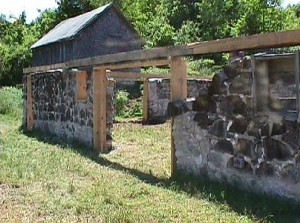August Beck Barn
 Although the Beck Barn no longer stands, the foundation which remains is still a very interesting element of the island. The remnants reveal that the barn was built using the stovewood construction technique, consisting of logs laid in mortar. It was likely built when most of the island’s large trees had already been cut for profit rather than used for construction on the island.
Although the Beck Barn no longer stands, the foundation which remains is still a very interesting element of the island. The remnants reveal that the barn was built using the stovewood construction technique, consisting of logs laid in mortar. It was likely built when most of the island’s large trees had already been cut for profit rather than used for construction on the island.
Although the stovewood building technique was possibly a tradition from the Beck’s German heritage, it also may have been a technique born of necessity and available materials. These types of buildings can be found in other areas of the western Upper Peninsula of Michigan and northern Wisconsin, and are associated with areas that were cutover before immigrant families attempted to settle.
The farmers could not afford high quality timber, and instead opted for simple, yet effective, stovewood. When the Beck barn was still standing, it was two stories tall with a wooden frame and a gable roof. Its main use was for livestock and hay, and it also had running water which was pumped by the nearby windmill.
August Beck Barn Foundation Repaired
In 2005, the National Park Service, South Manitou Memorial Society, Michigan Barn Preservation Network, Preserve Historic Sleeping Bear, and the Manitou Island Transit, all partnered to work on the repair and stabilization of the August Beck Barn Foundation on South Manitou Island.
The foundation made of stacked white cedar cordwood set in mortar is the only port ion of the barn that still remains. The stacked cordwood resembles stacks of wood you would find in your wood pile. The work is not complicated and represents a time when trees were abundant and labor was unskilled. The barn was constructed in the early 1880s.
The project included rebuilding deteriorated walls, stabilizing existing cordwood walls, and rebuilding deteriorated window and door openings. The first volunteer effort was to locate and harvest white cedar. Harvesting began in October 1999 in some of the coldest weather, with seven local volunteers and timber framers lending their time and expertise and muscle to cut and drag white cedar from a swamp near Suttons Bay. Once the wood was hauled from the swamp, the bark had to be stripped and the logs bucked into fire wood size pieces and stacked into a trailer. The trailer was then hauled to the park and stored for the winter so the logs could be dry prior to use in the project.


 Official Partner of the
Official Partner of the